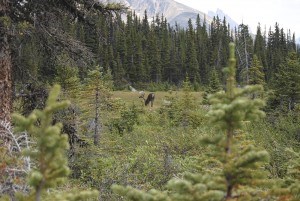
In a sign of greater openness and transparency, Parks Canada invited local media to a face-to-face meeting with senior staff to discuss the ecological monitoring and restoration activities currently taking place in Jasper National Park.
While the meeting touched on some important topics, it signalled a change in policy under the Liberal government, which has promised a more open and transparent government.
“What we wanted to do, rather than the traditional over the phone interview, is to give you an overview of the ecological monitoring programs so you understand exactly what we do and why we do it,” said Steve Young, communications officer for Jasper National Park.
In attendance was Salman Rasheed, Jasper’s acting resource conservation manager, and Resource Management Officer, Steve Malcolm.
The following is a brief break down of three ecological monitoring and restoration programs currently taking place in Jasper National Park.
Whitebark pine tree recovery strategy (pending)
Although the recovery strategy to protect the endangered whitebark pine tree is pending, Parks Canada has begun to take an aggressive approach to restoring the species, explained Rasheed.
To do that, Parks has taken a three-pronged approach by monitoring and surveying where the species is, identifying tree stands that are resistant to white pine blister rust (the pathogen that is killing the trees), and replanting disease resistant seedlings.
“In stands where we identify high occurrences of white pine blister rust and healthy trees we cage the cones on those healthy trees. The premise is if you’re a healthy tree in a heavily infested stand you must have some resistance to blister rust,” explained Rasheed.
From there, Parks staff harvest the seeds and use them to grow saplings at nurseries.
According to Rasheed, the seedling take from two to five years to grow before they can be planted.
He said Parks intends to begin planting the seedlings in 2017.
Caribou recovery strategy
The woodland caribou recovery strategy was released by Environment Canada in 2012 and was quickly implemented by Parks across Canada’s mountain national parks.
Woodland caribou in Banff, Jasper, Mount Revelstoke and Glacier national parks belong to the threatened Southern Mountain population.
In Jasper there are four main herds all of which are in decline, including the Maligne and Brazeau herds, which have less than 10 remaining animals each.
According to Rasheed, Parks has identified five threats facing the caribou, with predation being the most significant threat facing Jasper’s herds.
To reduce that risk, for the past two years Parks has delayed winter access to the Tonquin, Maligne-Brazeau and North Boundary areas of the park.
“The intent is that if we don’t have skiers and other visitors going to these places they’re not packing down trails and the reason we’re concerned about packed down trails is because it facilitates predator access,” said Rasheed.
During the discussion, a question was raised about why Parks keeps Maligne Lake Road open to cars during the winter, if the intent is to stop people from accessing the valley.
“Where the caribou are in the higher elevations I think we're achieving both things; getting visitors to places where they can truly appreciate national parks in the winter as well as protecting caribou during those sensitive months,” said Rasheed.
The Tonquin area will reopen for winter recreation on Feb. 16, 2016. All other areas will reopen Feb. 29, 2016.
In addition to the closures, Parks is also focused on educating the public about caribou through initiatives such as the Caribou Ambassador Program, which teaches volunteers about the endangered animal and in turn asks volunteers to share their knowledge with the wider public.
Fire and vegetation management program
Recognizing that fire is an integral part of the ecosystem, Parks has reintroduced fire across Canada’s national parks.
According to Parks, the suppression of naturally occurring wildfires over the last 100 years has created less diverse forests, forests that are more susceptible to insects and disease and increased the chance of catastrophic wildfires.
In Jasper, prescribed burns not only help to restore the ecosystem, but are also used to slow the spread of the mountain pine beetle and help to protect property.
The most recent prescribed burn was the Vine Creek prescribed fire in May.
Paul Clarke
[email protected]
